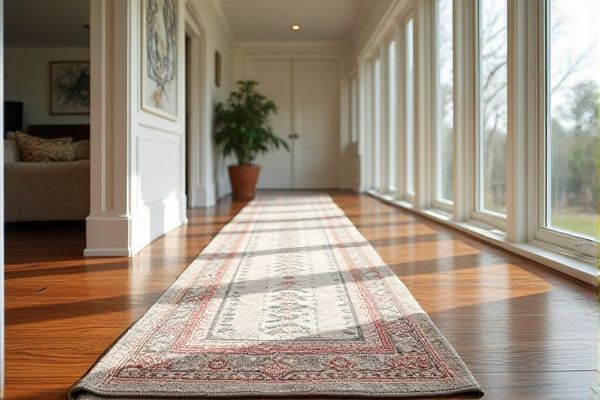
Choosing between a patterned runner and a solid color runner depends on your style preference and the room's existing decor, as patterned runners add visual interest and texture while solid colors provide a seamless, minimalist look. Discover how each option can transform your space and find the perfect runner to complement your home by reading the rest of the article.
Table of Comparison
| Feature | Patterned Runner | Solid Color Runner |
|---|---|---|
| Design | Multiple motifs, shapes, and colors | Single, consistent color |
| Style | Bold, decorative, eye-catching | Minimalist, versatile, understated |
| Room Suitability | Living rooms, halls with simple decor | Any room, adaptable to various styles |
| Maintenance | Can hide stains better | Shows stains and dirt more easily |
| Visual Impact | Adds texture and depth | Creates sleek, clean lines |
| Price Range | Moderate to high depending on pattern complexity | Usually affordable with wide price range |
| Trend | Trendy, bold statement pieces | Classic and timeless choice |
Introduction to Patterned and Solid Color Runners
Patterned runners offer dynamic visual interest with diverse designs that can enhance your space by adding texture and personality. Solid color runners provide a clean, versatile foundation that complements various decor styles without overwhelming the room. Choosing between patterned and solid color runners depends on the desired aesthetic impact and how the runner integrates with your existing interior elements.
Key Differences Between Patterned and Solid Color Runners
Patterned runners feature intricate designs or motifs that add visual interest and can act as focal points in your space, while solid color runners offer a uniform and versatile look that complements various decor styles. The complexity of patterned runners can effectively hide dirt and wear, making them practical for high-traffic areas, whereas solid color runners emphasize simplicity and can make a room feel larger and more cohesive. Choosing between the two depends on whether you want to highlight your hallway with bold aesthetics or maintain a subtle, minimalist appearance.
Visual Impact: Patterns vs. Solids
Patterned runners create dynamic visual interest by incorporating intricate designs and varied colors, making them ideal for adding personality and depth to a space. Solid color runners offer a clean, minimalist aesthetic that can seamlessly blend with various decor styles while emphasizing simplicity and cohesion. The choice between patterned and solid runners depends on the desired visual impact: bold and attention-grabbing versus subtle and harmonious.
Versatility in Home Décor
Patterned runners introduce dynamic visual interest and can easily complement eclectic or modern interior styles, making them ideal for spaces that embrace bold design elements. Solid color runners provide a neutral foundation, enhancing versatility by seamlessly blending with any decor theme from minimalist to traditional. Both options offer unique benefits, with patterned runners acting as focal points and solid runners offering subtle cohesion in home decor.
Maintenance and Cleaning Considerations
Patterned runners effectively conceal dirt, stains, and wear, making them easier to maintain in high-traffic areas, while solid color runners tend to show dirt and stains more prominently, requiring more frequent cleaning. You should use appropriate cleaning methods such as vacuuming, spot cleaning, and professional deep cleaning tailored to the material and color of your runner. Opt for stain-resistant or easy-care materials to simplify maintenance regardless of whether you choose a patterned or solid color runner.
Room Size and Spatial Perception
Patterned runners create depth and dimension, making small or narrow rooms appear larger by drawing the eye along varied designs. Solid color runners offer a streamlined, continuous look that enhances the perception of length in larger spaces without overwhelming the room. Selecting between patterned and solid runners can strategically influence spatial perception, optimizing room size and flow.
Matching Runners With Existing Furniture
When matching patterned runners with existing furniture, consider the color scheme and texture of upholstery to create a balanced visual appeal. Solid color runners complement diverse furniture styles by providing a neutral base that enhances surrounding decor without overwhelming patterns. Selecting runners that either echo or contrast furniture tones helps unify the room's design while maintaining harmonious flow.
Cost Comparison: Patterned vs. Solid Color Runners
Patterned runners often cost more than solid color runners due to the complexity of designs and additional manufacturing processes involved. Solid color runners typically offer a budget-friendly option with consistent pricing across various materials and sizes. Choosing your runner depends on your style preference and budget, with patterned runners providing visual interest and solid runners offering simplicity and cost efficiency.
Best Places to Use Each Runner Type
Patterned runners are ideal for high-traffic areas like hallways, kitchens, and entryways, where they effectively conceal dirt and wear while adding visual interest. Solid color runners work best in minimalist or modern spaces such as bedrooms and living rooms, providing a clean, cohesive look that complements existing decor. Choosing the right runner depends on balancing durability needs with design preferences specific to each location.
Choosing the Right Runner for Your Lifestyle
Patterned runners add visual interest and can effectively hide stains or wear in high-traffic areas, making them ideal for busy households or entryways. Solid color runners offer versatility and create a seamless look, better suited for minimalist or modern interiors where subtlety is preferred. Evaluate your lifestyle needs, traffic levels, and decor style to select a runner that complements both your aesthetic and practical requirements.
 homyna.com
homyna.com